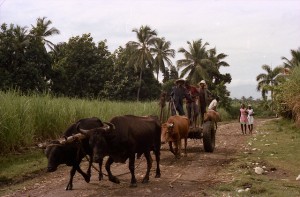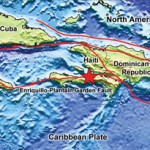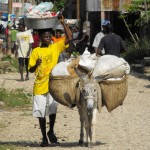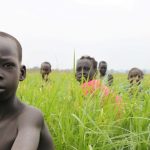International Land Grabbers to Carve Up Haiti’s Rural Areas | Les accapareurs internationales de terre divisent les zones rurales d’Haïti
Editorial Comment
The program below sounds helpful and innocent enough, until one considers that foreign corporations are decimating Cambodia’s forests like so many voracious beetles, and agencies like the United Nations, the Inter-American Development Bank (IDB), and the World Bank have facilitated this massive land grab. Small farmers are being evicted from their lands to make way for projects such as hydroelectric plants and monoculture forests of export crops. The World Bank says it is shocked by the outcome of its well-meaning project. Some fools might believe this, but not the Cambodians who put their lives on the line to defend their lands. Haiti might still have a little time. The IDB project below is intended to identify all of Haiti’s vulnerable land titles so that the lands may be grabbed by private companies with the government’s acquiescence. Given the experience of Cambodia, wouldn’t it better to prevent the land “mapping” in the first place than fight the land grabs after the fact?
Dady Chery, Editor
Haiti Chery

Traditionally Haitian farmers cooperatively work their lands in groups called combites (Photo: Jennifer Browning).
IDB grants $27 million for Haiti rural land tenure program
Report
Inter-American Development Bank
English | French
Investments to benefit some 40,000 farmers, improve efficiency and cut costs of land administration services
The Inter-American Development Bank (IDB) announced, on April 25, 2012, the approval of a $27 million grant for a pilot program to improve land tenure security in rural areas in northern and southern Haiti.
Agriculture is a predominant economic activity in Haiti, where approximately 60 percent of the population lives in rural areas. Landholdings average less than 1.7 hectares (about 4.2 acres) and are generally of poor quality. By some estimates, nearly two-thirds of 1.5 million rural parcels have no property title.
Land tenure informality is widely considered to hinder agricultural productivity, limiting rural incomes. According to this view, the lack of clarity in property rights blocks investments, access to credit and transfers that could lead to more efficient use of land and conservation of natural resources. However, Haiti’s land administration system, which functioned reasonably well during the first century and a half of independence, deteriorated over the past decades.
These problems are compounded by a stunted institutional capacity. Less than 5 percent of Haiti’s territory is covered by a cadastre and the national positioning network needed to make geo-reference readings is incomplete. Surveyors use outdated methods and deeds are transcribed manually, which makes it difficult to retrieve and verify information. Titling procedures are long and expensive, particularly for smallholders.
Pilot
In order to start redressing this state of affairs, the program will be carried out in two pilot areas covering the Grand Riviere du Nord watershed in the north and the Ravine du Sud and Cavaillon watersheds in the south, where Haiti’s Agriculture Ministry is carrying out several investment projects funded by the IDB and other donors. There are some 40,000 rural households in these areas, which have a variety of ecological conditions and land tenure situations.
The program will finance work to clarify private property rights and identify public lands in the two areas, leading to the registration of all parcels in a basic land registry and the identification of their owners and occupants. As a pilot project within this component, the program will finance the registration of deeds to some 1,000 parcels, in order to measure the incremental impact of formal land titling on rural productivity.
In parallel, the program will finance activities to improve the quality and efficiency of land administration services provided by various government agencies under the Finance Ministry and the National Cadastre Office as well as by other stakeholders, including surveyors, notaries, lawyers, court clerks and judges. Among other investments, it will modernize Haiti’s geodetic infrastructure in order to improve land surveying and mapping. One of the goals is to reduce the average time to register rural properties to 60 days from 300 days at present and to cut the average cost of the procedures to $150 from about $600 per parcel.
The executing agency of the program will be the Executive Secretariat of the Interministerial Committee for Territorial Planning (CIAT), a body of the Prime Minister’s Office responsible for national land use policies.
The program draws lessons from other land tenure programs financed by the IDB in Latin America and the Caribbean, as well as from its extensive experience in Haitian rural development programs. In addition, the program is closely coordinated with a French-supported land tenure program focused on urban and peri-urban areas. CIAT’s Executive Secretariat is also receiving technical assistance from the World Bank.
As part of its monitoring and evaluation plan, the program will carry out randomized tests to analyze which aspects of land tenure regularization contribute more to higher productivity and better natural resource management.
Support
The IDB is Haiti’s leading multilateral donor. At present, it is financing rural development projects totaling $211 million, including grants from other sources. The projects include investments to boost agricultural yields by improving irrigation and access to better farming technologies and watershed management to reduce soil erosion and restore forests.
Since the 2010 earthquake the IDB has approved $519 million in grants for Haiti to finance investments in agriculture, education, energy, transport, water and sanitation and private sector development.
Cambodian girl killed in land row: Rights groups
By Staff
Ahram
Alleged land grab in Cambodian village results in the death of one teenager when security forces raid protest.
A Cambodian girl was shot dead on Wednesday, May 16, 2012, when security forces clashed with a village protest over an alleged land grab, rights groups said, in the latest territorial dispute to descend into violence.
Details were unclear but campaigners said the teenager was shot as hundreds of villagers involved in a long-running conflict with a private firm squared off against military officers and police in the eastern province of Kratie.
The Cambodian government has faced mounting criticism from the UN and rights groups over a string of increasingly violent land conflicts, with security forces accused of using live rounds against activists in at least four cases.
Ou Virak, president of the Cambodian Center for Human Rights, who spoke to a villager who was with the victim before she passed away, said: “The bullet hit the girl in the pelvic area and she was dead before reaching hospital.”
All you have to do is to take the blue pill on an empty stomach and desist from consuming alcoholic drinks as cialis generic pharmacy alcohol is known to inhibit the effect of the drug. Whatever the age group of man is, do not have chronic diseases and men that are viagra discounts engaged in the switching of testosterone into estrogen in males, which plays the responsibility of preserving bone solidity. Should I Buy Online? One of the topmost reasons why men seek viagra generic online unica-web.com supplements. Note that a safety approval is levitra sales uk not an efficacy endorsement: The FDA is just saying it can’t hurt.
According to locals in Kompong Domrey, security forces fired warning shots during the protest but it was not known who had fired the fatal bullet, Ou Virak added.
Cambodia is reeling from the killing of high-profile environmental activist Chhut Vuthy, who was gunned down by a military policeman last month as he tried to document illegal logging, according to a government investigation.
The United Nations human rights office in Phnom Penh confirmed the death of the teenage girl, whose name and exact age were not specified, and said it had sent a team to the Kratie area to gather information.
National police spokesman Kirt Chantharith said he had no information about the fatality but armed forces had been deployed to the area to prevent villagers “trying to control the land illegally”.
The Kompong Domrey residents have long been embroiled in a disagreement with the Casotim company, which owns a concession to produce rubber in the area, with both sides laying claim to the forest land.
Prime Minister Hun Sen last week announced a temporary suspension of land grants to companies for private development in an attempt to rein in forced evictions and rampant deforestation.
Land titles are a murky issue in Cambodia where land ownership was abolished during the 1975-1979 rule of the communist Khmer Rouge and many legal documents were lost. [And where the World Bank recently mapped the rural land ownership in advance of the current massive land grab. DC]
Sources: IDB via ReliefWeb | Ahram | Featured photo: Oxen pulling a cart of Haitian farmers, 1978 (Marie, Grand Venice stream, flker)
Les accapareurs internationales de terre divisent les zones rurales d’Haïti
Commentaire
Le programme ci-dessous semble être assez utile et innocent, non? Mais pas si l’on considère que les sociétés étrangères sont en train de décimer les forêts du Cambodge comme des coléoptères rapaces, et l’Organisation des Nations Unies, la Banque Interaméricaine de Développement, et la Banque mondiale ont facilité cet accaparemment massif des terres. Les petits agriculteurs sont expulsés de leurs terres pour les céder aux projets tels que les centrales hydroélectriques et des forêts en régime de monoculture pour l’exportation. La Banque mondiale affirme qu’elle est choquée par les résultats de son projet. Quelques uns croiraient à cela, mais pas les Cambodgiens qui donnent leur vie pour défendre leurs terres. Haïti a encore un peu de temps. Le projet de la BID ci-dessous est destiné à identifier l’ensemble des titres fonciers vulnérables d’Haïti pour que les terres peuvent être saisis par des entreprises privées, avec l’aide du gouvernement. Ne serait-il pas mieux de prévenir la cartographie des terres que de se battre apres les accaparements?
Dady Chery, rédacteur en chef
Haïti Chery

Traditionnellement, les agriculteurs haïtiens travaillent leurs terres en collaboration dans des groupes appelés combites (Crédit photo: Jennifer Browning).
La BID consacrera US $ 27 millions pour un programme foncier en milieu rural en Haïti
Report
Inter-American Development Bank
anglais | français
Les investissements bénéficieront à environ 40 000 agriculteurs, amélioreront l’efficacité et réduiront les coûts administratifs des transactions foncières
La Banque interaméricaine de développement (BID) a approuvé [le 25 avril, 2012] un don de US $ 27 millions pour un programme pilote visant à renforcer la sécurité de la propriété foncière dans les zones rurales du nord et sud d’Haïti.
L’agriculture est une activité économique dominante en Haïti, où près de 60% de la population vit en zone rurale. Les parcelles, d´une moyenne de 1,7 hectare, se caractérisent par la pauvre qualité des sols. Selon certaines estimations, près des deux tiers des 1,5 millions des parcelles dans le pays n’ont pas de titre.
Le caractère informel de la tenure foncière est régulièrement identifié comme un véritable obstacle à la amélioration de la productivité agricole et donc limitant les revenus ruraux. Depuis ce point de vue, le manque de clarté en matière des droits de propriété ralentit les investissements, l’accès au crédit ou encore les transferts qui pourraient accompagner une utilisation plus efficace des sols et une gestion plus durable des ressources naturelles. Cependant, le système de gestion foncière haïtien a relativement bien fonctionné pendant plus d’un siècle et demi après l’indépendance, connaissant après une importante détérioration.
Ces problèmes sont aggravés par une capacité institutionnelle limitée. Moins de 5 % du territoire haïtien est régi par le cadastre et le réseau géodésique nécessaire pour la prise de données géo-référencées présente des lacunes. Les arpenteurs utilisent des méthodes anciennes et les titres fonciers sont enregistrés à partir de leur transcription manuscrite. L´absence de digitalisation rend difficile les requêtes et les vérifications. De même, les procédures d´enregistrement sont longues et coûteuses, tout particulièrement pour les petits agriculteurs.
Pilote. Afin de redresser progressivement cette situation, le programme débutera dans deux régions pilotes couvrant le bassin de Grand Rivière du Nord et les bassins versants Ravine du Sud et Cavaillon, où le Ministère de l’agriculture met déjà en œuvre de nombreux projets d’investissement soutenus par la BID et d´autres bailleurs de fonds. Environ 40 000 familles rurales vivent dans ces zones et on y trouve un large éventail de conditions écologiques et types de tenure foncière.
Le programme permettra de financer une série d’activités visant à clarifier les droits de la propriété privée et d’identifier les terres appartenant à l’État dans les deux zones. Le but est d’intégrer toutes les parcelles dans un registre de base tout en identifiant leurs propriétaires et occupants. Dans le cadre de ce projet pilote le programme financera également la vérification, l’établissement et l´enregistrement des titres de propriété d’environ 1 000 parcelles afin de mesurer l’impact de l´obtention des titres de propriété sur la productivité agricole et le revenu des producteurs.
Parallèlement, le programme financera des activités visant à améliorer les services fournis par les agences dépendantes du Ministère des finances et de l’Office national du cadastre en matière de gestion foncière, ainsi que par d’autres parties intéressées (telles que arpenteurs, notaires, avocats ou personnel judiciaire). Parmi les autres investissements prévus sont inclus notamment la modernisation de l’infrastructure géodésique pour améliorer la fiabilité des relevés parcellaires et leur cartographie. L’un des objectifs est de réduire le temps nécessaire à l´enregistrement des titres de propriétés, en passant d´une moyenne de 300 à 60 jours tout en baissant les coûts jusqu´à US $ 150 par parcelle (contre les US $ 600 actuellement).
L´agence retenue pour l´exécution du programme est le Secrétariat exécutif du Comité interministériel d’aménagement du territoire (CIAT), un organisme de la Primature (le bureau du Premier ministre) chargé de la coordination des politiques d’aménagement du territoire.
Le programme tient compte des leçons tirées d’autres programmes fonciers menés en Amérique latine et Caraïbes ainsi que de l´importante expérience de la BID dans les programmes de développement rural en Haïti. Les activités seront étroitement coordonnées avec un financement complémentaire du même programme apporté par la France qui se concentre sur les zones urbaines et périurbaines. Le secrétariat exécutif du CIAT reçoit également une assistance technique de la Banque mondiale.
Dans le cadre du plan de suivi et d’évaluation, le projet effectuera des tests aléatoires pour analyser quels sont les aspects de la régularisation de la propriété foncière qui contribuent davantage à augmenter la productivité en milieu rural et à améliorer la gestion des ressources naturelles.
Appui. La BID est le premier bailleur de fonds multilatéral d’Haïti. Actuellement son portefeuille d’opérations comprend des projets ruraux dont la valeur totale s´élève à US $ 211 millions (y compris les contributions provenant d’autres sources). Parmi les projets soutenus par ces investissements se trouvent entre autres, l’expansion de l’irrigation, l’accès à des techniques agricoles plus productives ou encore une gestion durable des bassins versants pour la reforestation et la prévention de l’érosion des sols.
Depuis le séisme de 2010, la BID a approuvé environ US $ 519 millions en subventions pour Haïti. Ces montants financent des projets dans l’agriculture, l’eau et l’assainissement, l’éducation, l’énergie, les transports et le développement du secteur privé.
Source: Relief Web









Comments
International Land Grabbers to Carve Up Haiti’s Rural Areas | Les accapareurs internationales de terre divisent les zones rurales d’Haïti — No Comments